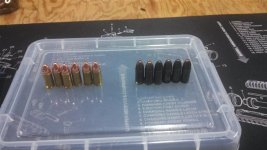Yes, putting a label on the box, marking the brass, etc. I know that those are easy solutions that work in most cases but this is as much curiosity as anything else. Unfortunately, those don't really help make brass standout at the indoor range and they do necessitate separate boxes for each load. Remember too these labeling schemes based on components require some familiarity with reloading or guns in general which will be important in my next paragraph. Simple is great, but when simple don't cut it you have to get more complicated but honestly it doesn't look that hard to do, it's high school chemistry I just wanted to see if anyone had experience with it.
Also, it's easy for us to remember what our own reloads are but I often take foreign grad students from my department with me to the range. Trying to explain to them that the 'hollow points' or 'round noses' (bizarre terms to foreign ears) are for this gun or the other is not simple, most don't comprehend that you can have different loads in the same caliber or different bullets for a given cartridge. The idea I had was you put the picture of the gun on the box the ammo is meant for and a colored sticker, the brass is colored as the sticker, a sticker is on the base of the grip. Like garanimals for guns and ammo.
When you have someone who can't tell a p08 from a 1911 or don't realize that guns are different from one another some redundancy is necessary. I love taking them, it's great and they really like it, but the less confusion for them the better for everyone. It also appeals to my OCD tendencies.
Anodizing is not just for aluminum, you just don't see other metals anodized very often: Ti, Zi, Mg, but I'm pretty sure you can't anodize brass (I'm more of a biochemist than an electrochemist so I might be wrong). I don't tumble but I'm not sure what my sonicator would do to patina my guess would be very little but I don't know. As for damaging the brass, I shoot patina'd brass frequently, yes patina is corrosion but it's a surface effect so I would think the integrity of the brass would be unaffected. As for acid and bases are relatively safe for brass, just not nitrogen containing bases like ammonia which attack a metal constituent in brass.
I think I'll try it once I move and post the results, make 50 colored and 50 normal. Load them, measure groups they should be the same, then sonicate once and get mass, then sonicate again and remeasure to see if there is noticeable patina loss. No good way to test brass lifespan. Maybe not practical but I'm a scientist.

